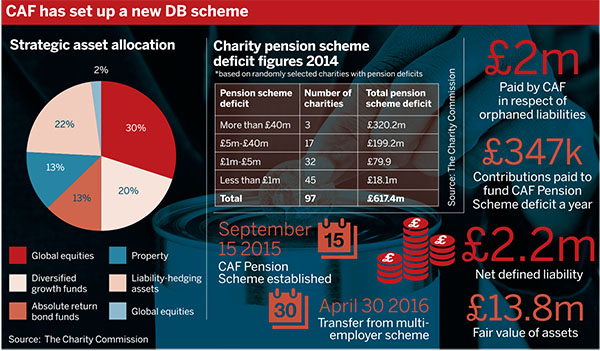The Charities Aid Foundation has withdrawn from a multi-employer defined benefit pension plan and established a new DB scheme, removing its exposure to other employers’ pension liabilities.
Multi-employer schemes have traditionally allowed charities to share administration costs and risks, but sharp increases in pension deficits means leaving a multi-employer scheme can be complex and costly.
The new CAF Pension Scheme “was established solely to receive a transfer from the Growth Plan, a multi-employer section of The Pensions Trust”, states the charity’s 2016 annual report.
Organisations who had just gone into Growth Plan 3 thinking it was a DC scheme finished up with a very material deficit
David Davison, Spence & Partners
The transfer meant that the net DB pension liability rose to £2.2m from £700,000 at April 2016, mainly as a result of a £2m obligation in respect of orphaned liabilities within the multi-employer plan. However, with the transfer the charity has settled all obligations to the Growth Plan.
CAF chief executive John Low said the CAF trustees “felt that they were anxious to secure the future pensions of current and previous employees, and thought the best way to do that was to transfer the assets and liabilities from The Pensions Trust into a new standalone DB scheme”.
The move allowed CAF to take a “longer-term view of the investments with a view to ultimately dealing completely with the deficit, and because CAF had a good covenant that was something that we could do”, Low said.

Another reason for withdrawing from the multi-employer scheme was the desire to close off a previously uncapped exposure to orphaned liabilities, he added.
Low said one of the main triggers for transferring out of the Growth Plan was that the “guarantees went from being defined contribution arrangements to DB”.
DC to DB
When the Pensions Trust’s Growth Plan 3 was launched, it was expected to be a DC scheme.
David Davison, director at consultancy Spence & Partners, said the difficulty was that the fund was providing a guarantee despite being a DC scheme, so “the government identified that… there was a risk that members wouldn’t get their full benefits” since as a DC scheme it was not safeguarded by the Pension Protection Fund.
This led to any DC schemes that provided a guarantee having to be reclassified as a DB scheme.
Consequently, “organisations who had just gone into GP3 thinking it was a DC scheme… finished up with a very material deficit”, said Davison.
He added that setting up a new scheme and transferring from a multi-employer scheme is “a very expensive process” and “incredibly complex”.
Collaboration and costs
Alistair Russell-Smith, partner at consultancy Hymans Robertson, said there are a number of things to watch out for when looking to do a bulk transfer from a multi-employer scheme.
“Firstly, and probably most importantly, you need the multi-employer scheme to agree to this transfer.” For them to agree, it needs to be in members’ best interests.
Russell-Smith said: “A really important thing is employer covenant, and the impact of you leaving that multi-employer scheme on the overall covenant of the scheme, so for example if you’re a very strong employer then you leave a multi-employer scheme, the covenant that gets left behind after you leave is going to be weaker” which can be a barrier for some charities when transferring.
Another difficulty is that it can be “expensive to implement”. In addition to any debts, charities also have to pay for actuarial, legal and covenant advice, and the charity will usually have to cover the multi-employer scheme’s costs, Russell-Smith pointed out.
Plumbing scheme plans to seek guidance from Scottish courts as government drags feet on s75
Plumbing Pensions’ prolonged consultation with a departing employer over its exit fee has brought to light fundamental problems with section 75 debt legislation as it currently stands for non-associated multi-employer schemes.
Anjelica Finnegan, senior policy and public affairs officer at the Charity Finance Group, said: “Multi-employer schemes were initially billed as a sensible option for charity pensions – especially smaller organisations.”
However, “the financial crisis has led to a drastic, long-term, fall in asset values meaning that multi-employer schemes have built up significant deficits”.
She added: “Section 75 rules often prohibit charities from taking steps to stop accruing liabilities – such as removing staff from the scheme – without triggering a cessation debt which is calculated on the basis of buying an annuity for scheme members.”














